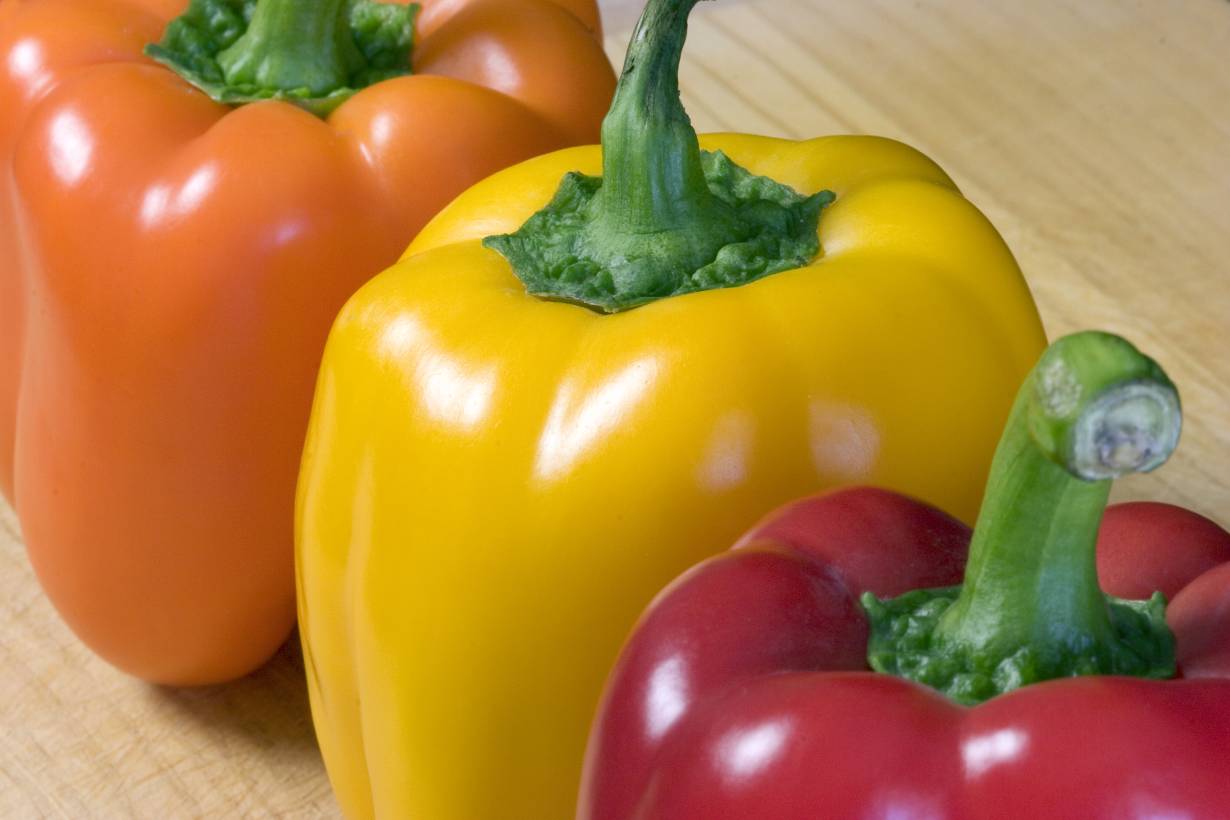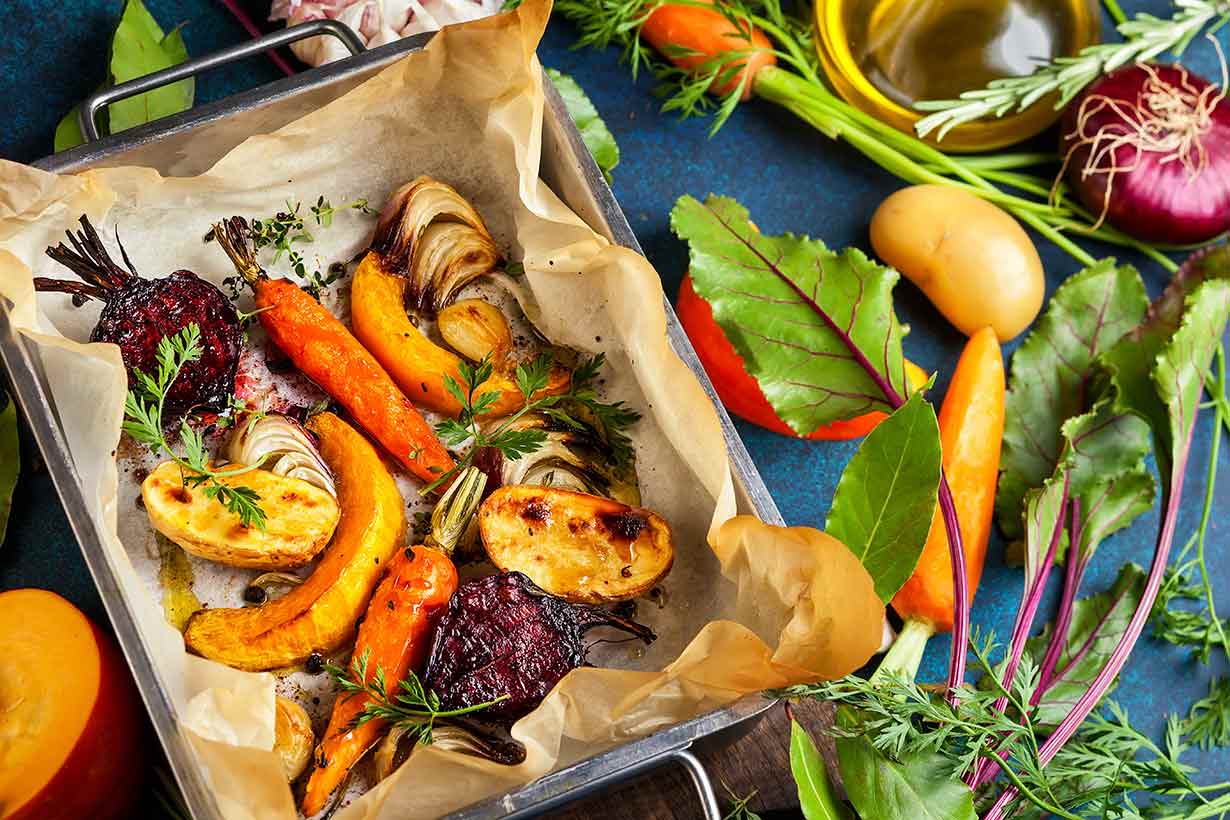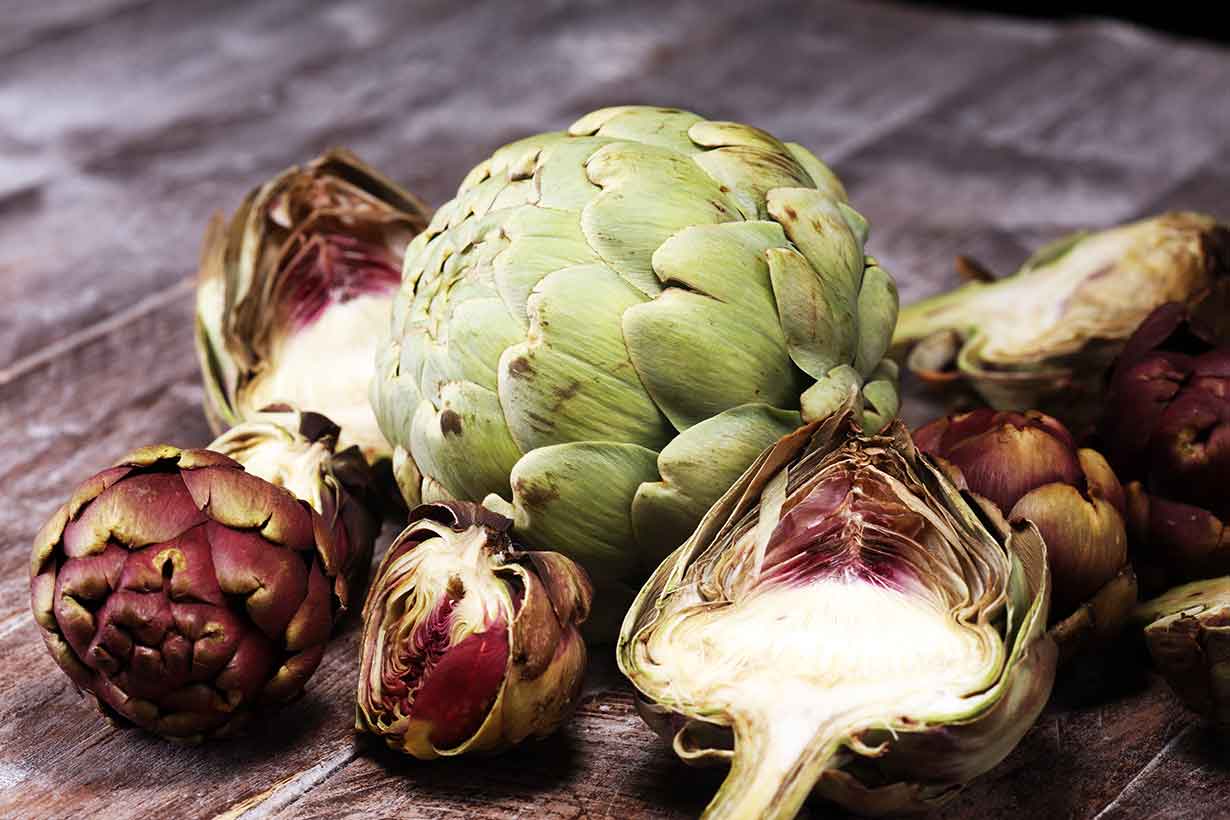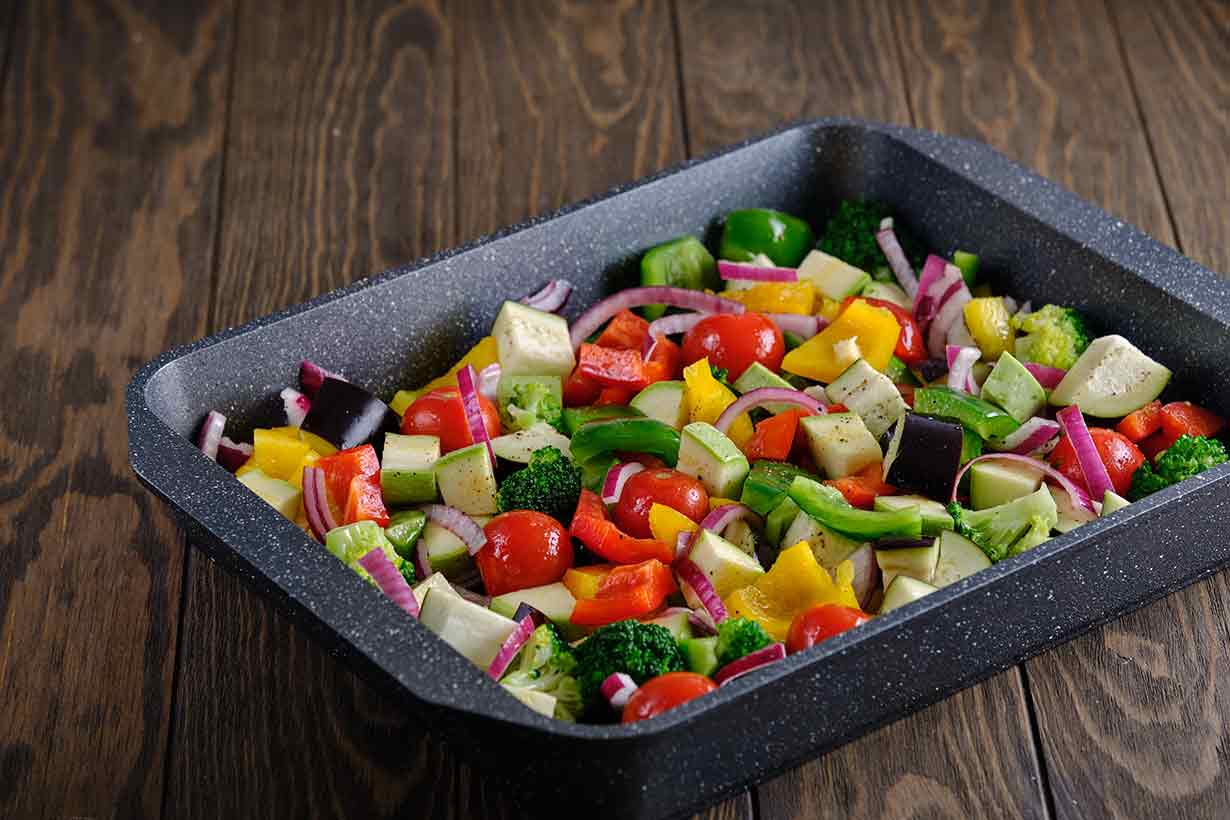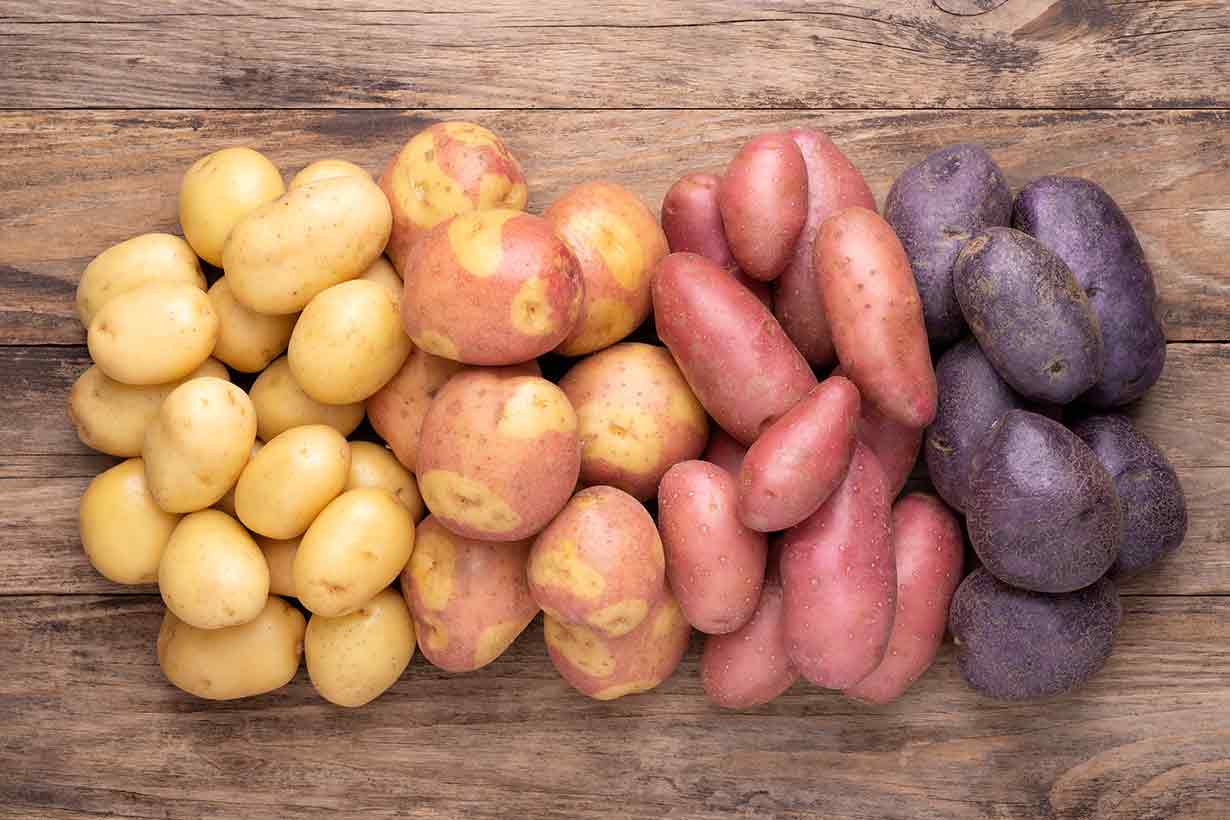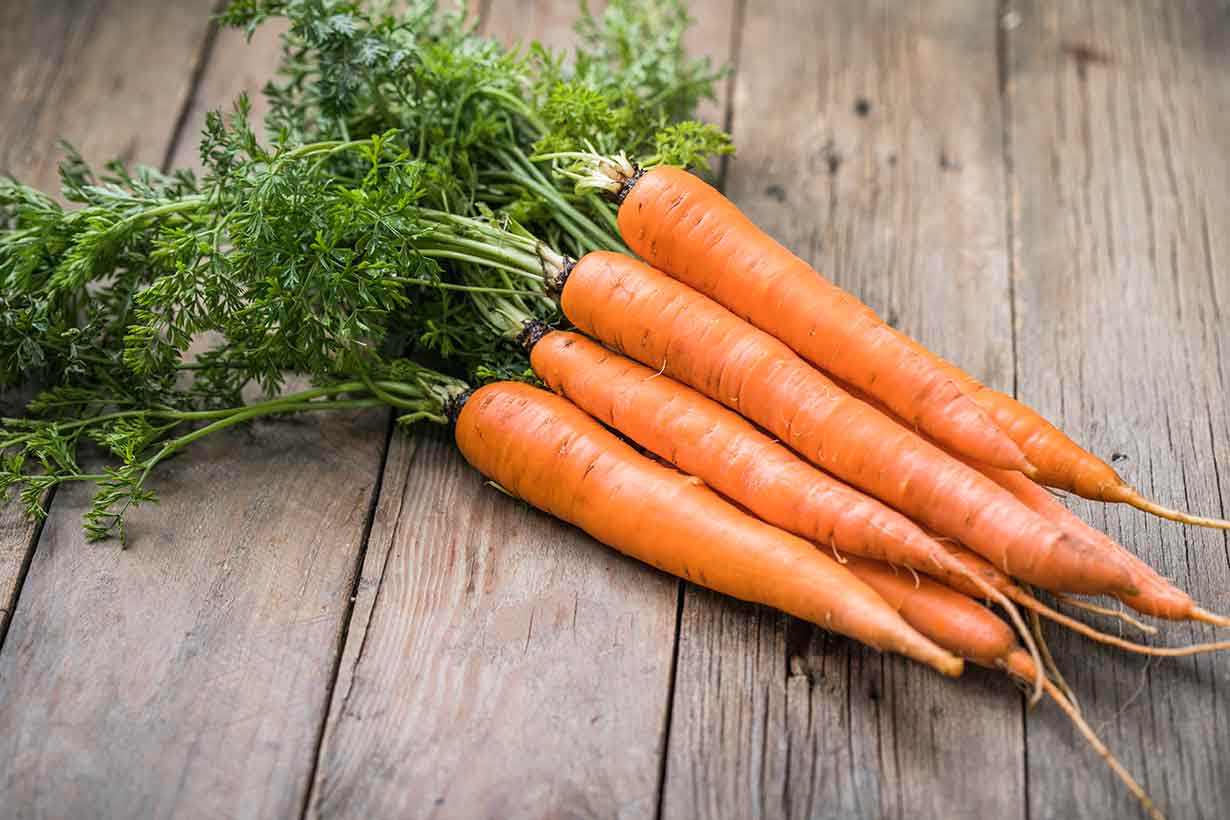Vegetables come in all kinds of different colors.
All vegetables are nutritious, but is there anything unique about red vegetables?
This article provides a list of 14 red vegetables and looks at some of their nutritional benefits.
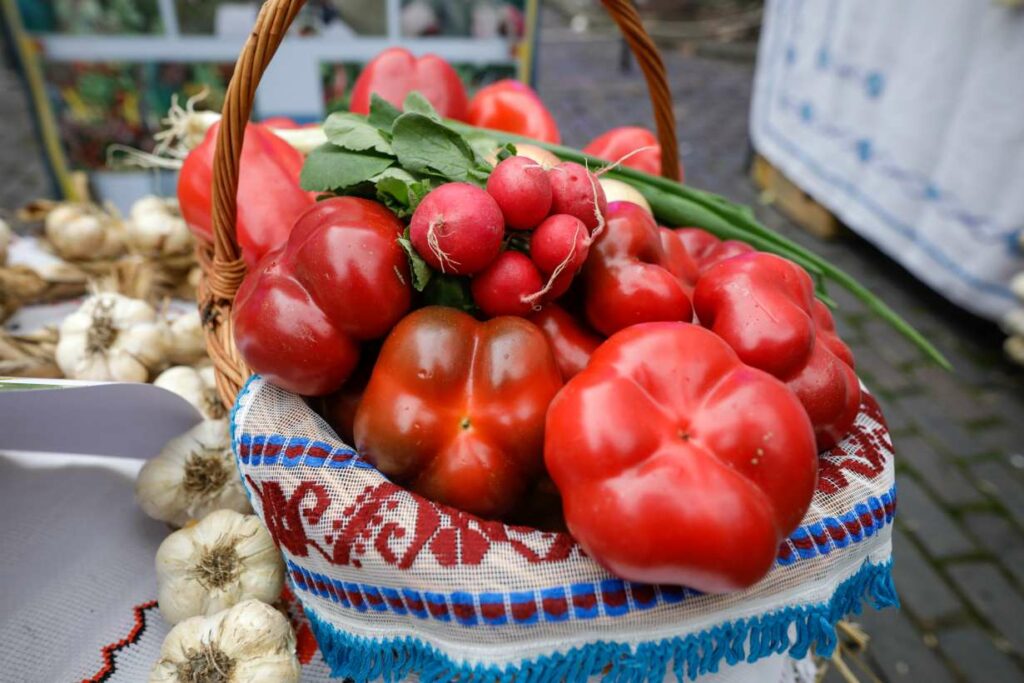
Table of contents
- What Vegetables Are Red and Why?
- Do Red Vegetables Contain Any Unique Nutrients or Provide Unique Benefits?
- A List of Red Vegetables
- 1) Beets
- 2) Radicchio
- 3) Radish
- 4) Red Amaranth Leaves
- 5) Red Bell Pepper
- 6) Red Cabbage
- 7) Red Carrots
- 8) Red Chili Pepper
- 9) Red Kuri Squash
- 10) Red Onion
- 11) Red Potatoes
- 12) Red Spinach
- 13) Rhubarb
- 14) Tomatoes
- Frequently Asked Questions
What Vegetables Are Red and Why?
There are numerous vegetables with red flesh or skin, and these include certain types of tubers, leafy vegetables, and more.
Firstly, these vegetables have a red color due to the bioactive phytonutrients they contain.
These red-pigmented compounds include anthocyanins, betacyanin, betalain, and carotenoids such as lycopene (1).
Some examples include beets and red spinach, which have a significant betacyanin content. Additionally, tomatoes contain high levels of lycopene, a red-pigmented carotenoid (2, 3, 4).
Do Red Vegetables Contain Any Unique Nutrients or Provide Unique Benefits?
Red vegetables’ vitamin and mineral content can be similar to green and yellow vegetables.
In other words, vegetable color doesn’t significantly influence a vegetable’s micronutrient content.
However, as previously mentioned, red vegetables contain higher levels of red-pigmented phytonutrients.
Depending on the specific vegetable, these phytonutrients may include phytonutrients such as betacyanin, betalain, and the carotenoid lycopene (5, 6).
The existing research base has shown some potential for betalain and betacyanin to improve exercise performance and possibly benefit cardiovascular health (7, 8).
Furthermore, a 2021 systematic review and meta-analysis examined the results of anthocyanin intake from 44 randomized controlled trials and 15 observational studies. The review found that anthocyanins may improve cholesterol levels. There were also strong associations between anthocyanins and lower cardiovascular disease incidence and lower cardiovascular mortality (9).
Regarding lycopene, this compound has been a source of much research interest.
Large systematic reviews have suggested lycopene may benefit cardiovascular risk factors (10). Furthermore, it may lower the risk of various adverse health outcomes, including all-cause mortality (11).
A List of Red Vegetables
Presented in alphabetical order, this list shows numerous red vegetable options alongside their characteristics and key nutritional qualities.
1) Beets
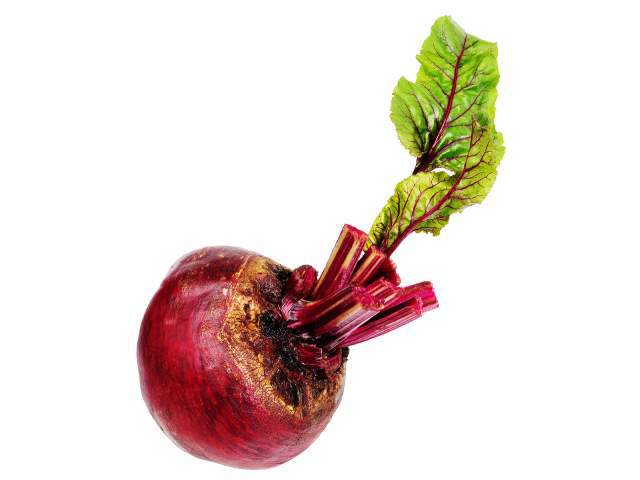
Beets are one of the most popular root vegetables. They have a reddish to purple color due to their betalain and betacyanin content (12).
Among the nutrients they contain, beets are an excellent source of folate.
A cup serving provides 136 mcg, which is 34% of the recommended daily value (% DV) (13).
Beets are versatile vegetables; people enjoy them raw, cooked, or even pickled.
Key Facts (Per 170g cup of cooked beets)
- Calories: 75 kcal
- Carbohydrates: 16.94 g
- Fiber: 3.4 g
- Sugars: 13.54 g
- Fat: 0.31 g
- Protein: 2.86g
- Key nutrients: Folate (41% DV), manganese (24% DV)
2) Radicchio
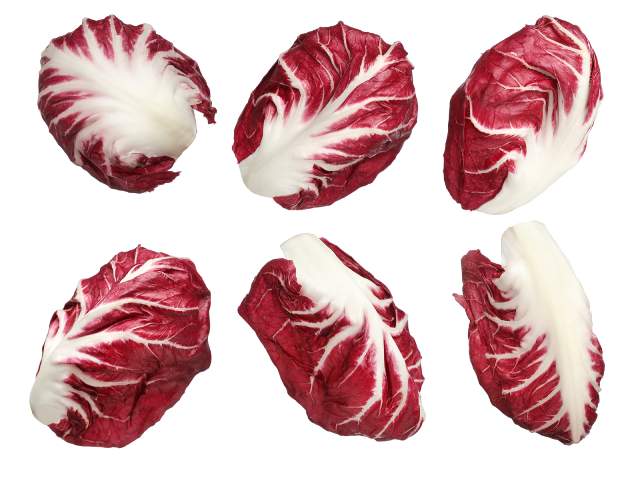
Radicchio is a popular leafy red vegetable that provides various essential nutrients.
The vegetable has a dark reddish-to-purple pigment due to the anthocyanins it contains (14).
A cup serving of radicchio has significant vitamin K levels. One cup provides 102 mcg of vitamin K, equal to 85% of the daily value (15).
Radicchio works well in raw salads and gives some flavor (and color) to stir-fries.
Key Facts (Per 40g cup of raw radicchio)
- Calories: 9 kcal
- Carbohydrates: 1.79 g
- Fiber: 0.36 g
- Sugars: 0.24 g
- Fat: 0.1 g
- Protein: 0.57g
- Key nutrients: Vitamin K (85% DV), copper (16% DV)
3) Radish

The radish is another red-colored root vegetable. Although often called ‘radish,’ the red variety is known as a table radish or ‘red radish.’
Red radishes mainly obtain red pigmentation from an anthocyanin called pelargonidin (16).
Regarding its vitamin and mineral profile, radish provides a good source of vitamin C. A cup serving of sliced radishes offers 14.80 mg of the vitamin, equal to 16% of the daily value (17).
Raw red radishes make a tasty addition to salads, and they can also be pan-fried for a softer texture and more mellow flavor.
Key Facts (Per 116g cup of sliced raw radish)
- Calories: 19 kcal
- Carbohydrates: 3.94 g
- Fiber: 1.86 g
- Sugars: 2.16 g
- Fat: 0.12 g
- Protein: 0.79g
- Key nutrients: Vitamin C (16% DV), folate (7% DV)
4) Red Amaranth Leaves
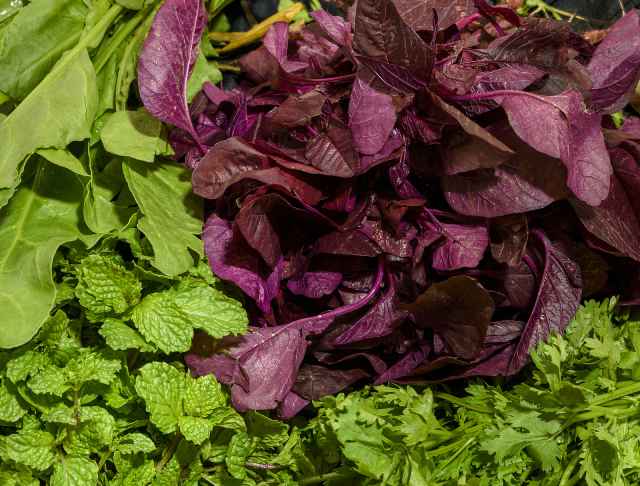
Red amaranth is a leafy vegetable in shades of red and purple.
Like many other leafy vegetables, red amaranth obtains its reddish color pigments from betalain, betacyanin, and carotenoids (18).
Regarding its nutritional profile, red amaranth provides high levels of vitamins C and K. Per cup serving of raw amaranth leaves; the vitamin K content is 319 mcg, which is 266% of the daily value (19).
There are several ways to use amaranth leaves; they can be steamed, stir-fried, or used raw in salads.
Key Facts (Per 28g cup of sliced raw amaranth leaves)
- Calories: 6 kcal
- Carbohydrates: 1.13 g
- Fiber: –
- Sugars: –
- Fat: 0.09 g
- Protein: 0.69 g
- Key nutrients: Vitamin K (266% DV), vitamin C (13% DV)
5) Red Bell Pepper
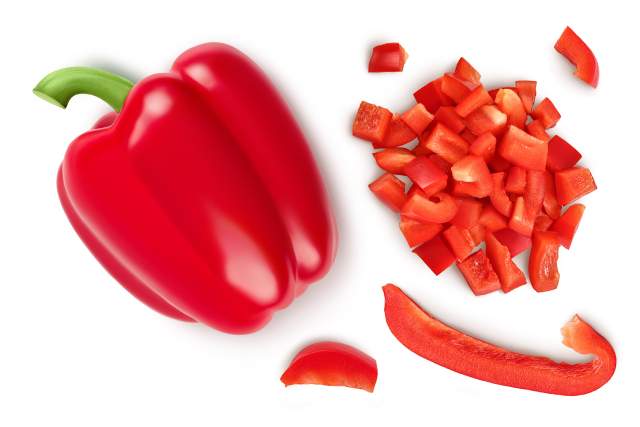
Peppers (capsicum annuum) are classed as fruits botanically (20).
However, people treat them as a vegetable for culinary purposes, using them in various savory dishes. For this reason, they are viewed as culinary vegetables (21).
High levels of carotenoids (capsanthin and capsorubin) are responsible for the bright red color of red bell peppers (22).
Among the nutrients they contain, red bell peppers are an excellent source of vitamin C. A medium-sized red bell pepper contains 152 mg of vitamin C, equal to 169% of the daily value (23).
Key Facts (Per medium 119-gram red bell pepper)
- Calories: 31 kcal
- Carbohydrates: 7.18 g
- Fiber: 2.5 g
- Sugars: 5.0 g
- Fat: 0.36 g
- Protein: 1.18 g
- Key nutrients: Vitamin C (169% DV), vitamin B6 (20% DV)
For more information, see this complete nutritional guide to bell peppers.
6) Red Cabbage
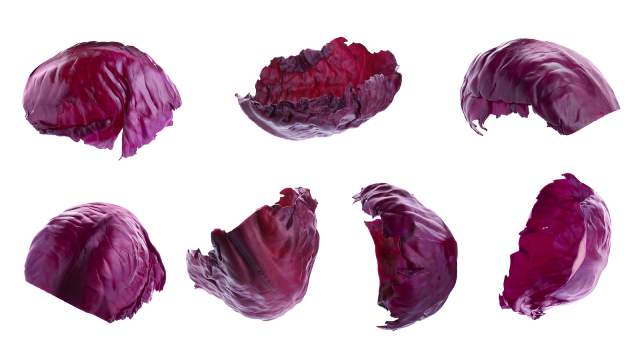
Red cabbage is a cruciferous vegetable with red to purple pigmentation. Compared to green cabbage, it has a slightly stronger and peppery taste.
The red pigments in red cabbage come from anthocyanins (24).
Red cabbage has a good vitamin C content, with a 75-gram half-cup serving providing 25.8 mg, 29% of the daily value (25).
This vegetable can add color to stir-fries and be a popular ingredient in fermented foods, such as red cabbage sauerkraut.
Key Facts (Per medium 75-gram half-cup serving)
- Calories: 22 kcal
- Carbohydrates: 5.2 g
- Fiber: 1.95 g
- Sugars: 2.49 g
- Fat: 0.07 g
- Protein: 1.13 g
- Key nutrients: Vitamin C (29% DV), vitamin K (30% DV)
7) Red Carrots
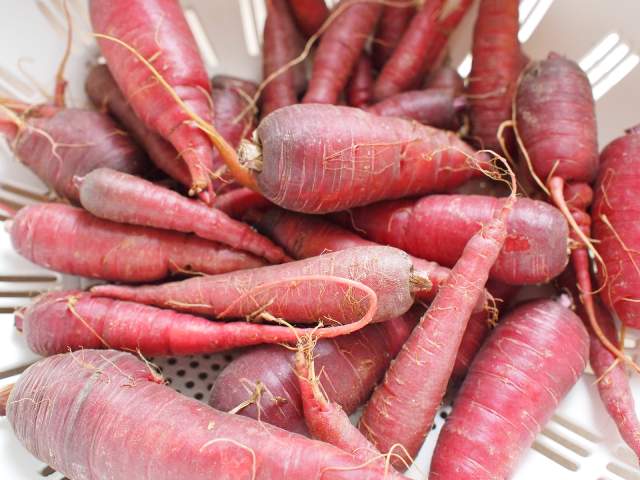
Some may be surprised by this, but carrots can come in many different colors rather than just orange.
Carrots can be yellow, orange, red, purple, or even black.
The difference between red carrots and regular orange carrots is that the former contains high amounts of lycopene (26).
However, from a crossover study involving nineteen participants, it appears that the lycopene in red carrots is only 44% as bioavailable as lycopene from tomato paste (26).
Key Facts
The USDA does not have an entry for red carrots in its nutrition database.
Furthermore, there does not appear to be a trustworthy source of nutritional data for red carrots in other major databases.
8) Red Chili Pepper
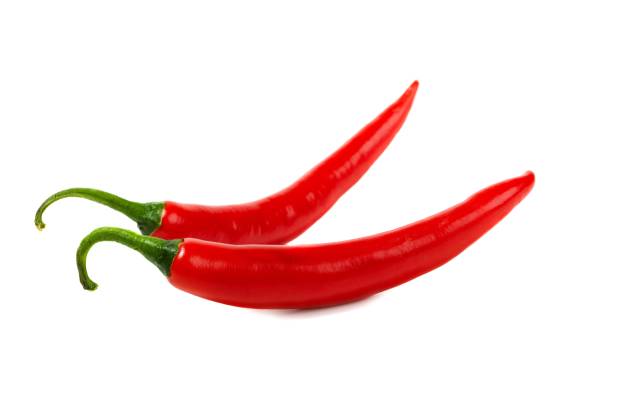
Like other peppers, red chili pepper is botanically a fruit rather than a vegetable. However, people use it more as a vegetable (or spice) in cuisines worldwide.
Six major carotenoids contribute to the red pigmentation of red chili peppers. These pigments include capsanthin, beta-cryptoxanthin, beta-carotene, capsorubin, zeaxanthin, and antheraxanthin (27).
Red chili peppers are also a surprisingly good source of vitamins and minerals.
For example, one 45-gram red chili pepper offers 64.8 mg of vitamin C, 72% of the daily value (28).
Among their many uses, red chili peppers are a natural fit for curries and can spice up soups and stews.
Key Facts (Per 45-gram red chili pepper)
- Calories: 18 kcal
- Carbohydrates: 3.96 g
- Fiber: 0.68 g
- Sugars: 2.38 g
- Fat: 0.20 g
- Protein: 0.84 g
- Key nutrients: Vitamin C (72% DV), vitamin B6 (13% DV)
9) Red Kuri Squash
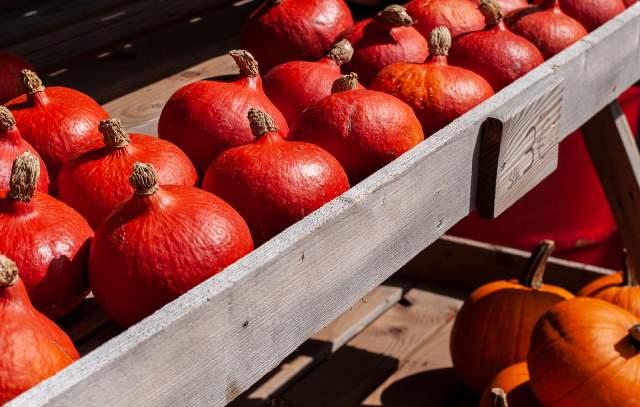
Red Kuri squash is a type of winter squash with an orange-to-red pigment.
Native to Japan, the taste of red Kuri squash is commonly said to evoke the flavors of chestnuts. Even the name ‘Kuri’ translates to ‘chestnut’ in Japanese (29).
Like other squash varieties, red Kuri squash makes a good ingredient for soups and stews. It can also be baked, boiled, mashed, or roasted, making it a versatile vegetable.
Unfortunately, no nutritional data for red Kuri squash has been published in reliable databases.
10) Red Onion
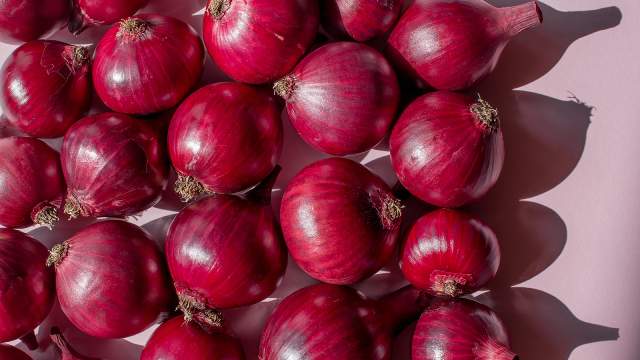
Red onions have a stronger and spicier flavor than regular onions and a red-to-purple pigment.
The red coloring comes from the high anthocyanin content of the onions (30, 31, 32).
All onions have a similar micronutrient profile; the most concentrated nutrient in red onions is vitamin C.
A large red onion contains 16 mg of vitamin C, equal to 18% of the daily value (33).
Key Facts (Per 197-gram red onion)
- Calories: 87 kcal
- Carbohydrates: 19.6 g
- Fiber: 4.33 g
- Sugars: 11.3 g
- Fat: 0.20 g
- Protein: 1.85 g
- Key nutrients: Vitamin C (18% DV), manganese (10% DV)
11) Red Potatoes
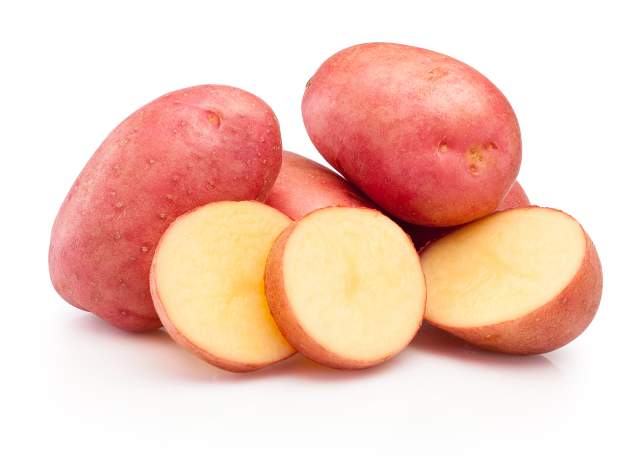
Red potatoes typically have red to pinkish-red skin and beige-to-white flesh.
The red skin is due to various anthocyanins being present in high concentrations (34, 35).
Like all potatoes, red-skinned potatoes provide significant amounts of nutrients such as vitamin C and potassium. For instance, a large baked red potato supplies 1630 mg of potassium, 35% of the daily value (34).
Key Facts (Per 299-gram large red potato, baked)
- Calories: 260 kcal
- Carbohydrates: 58.6 g
- Fiber: 5.38 g
- Sugars: 4.28 g
- Fat: 0.45 g
- Protein: 6.88 g
- Key nutrients: Potassium (35% DV), vitamin C (42% DV)
12) Red Spinach
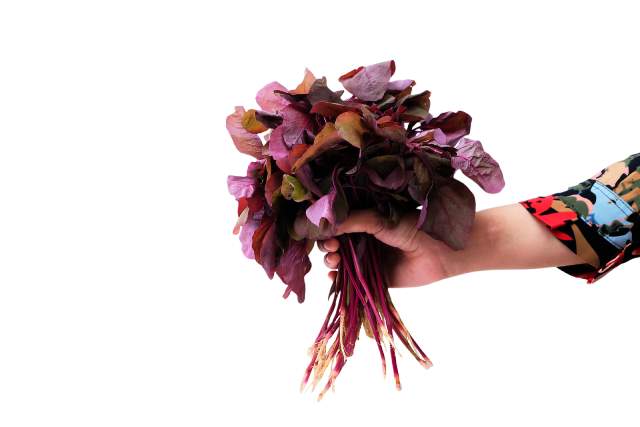
Red spinach is a type of leafy vegetable.
It is similar to regular spinach but has deep red stems due to its higher accumulation of anthocyanins (35).
Nutritionally, the primary nutritional databases do not differentiate between regular spinach and red spinach.
A cup of cooked spinach provides 889 mg of vitamin K, a substantial amount equal to 741% of the daily value (36).
Key Facts (Per 180-gram cup of cooked spinach)
- Calories: 41 kcal
- Carbohydrates: 6.75 g
- Fiber: 4.32 g
- Sugars: 0.77 g
- Fat: 0.47 g
- Protein: 5.35 g
- Key nutrients: Vitamin K (741% DV), vitamin C (73% DV)
13) Rhubarb

Rhubarb is often used in dessert recipes (alongside large amounts of sweeteners), so many presume it is a fruit.
However, rhubarb is a vegetable.
The large rhubarb stems obtain their bright red color from their anthocyanin content (37).
Like many other vegetables, the most concentrated micronutrients in rhubarb are vitamins C and K.
Each 51-gram stalk of rhubarb provides 14.9 mcg of vitamin K, 12% of the recommended daily value (38).
Key Facts (Per 51-gram stalk of rhubarb)
- Calories: 11 kcal
- Carbohydrates: 2.32 g
- Fiber: 0.92 g
- Sugars: 0.56 g
- Fat: 0.10 g
- Protein: 0.46 g
- Key nutrients: Vitamin K (12% DV), manganese (4% DV)
14) Tomatoes
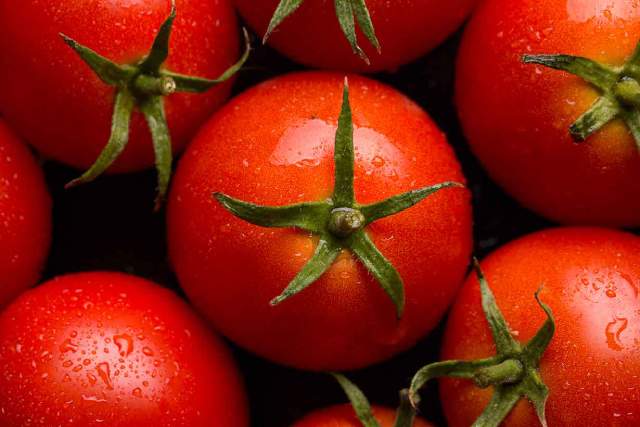
The tomato is another plant food that is botanically a fruit but used for culinary purposes as a vegetable.
Tomatoes are lycopene’s most significant dietary source, which explains their bold red color (39).
Interestingly, though, the bioavailability of lycopene vastly increases after processing, such as blending or cooking. This is because processing releases more lycopene from the cell walls of the tomato (40, 41).
For this reason, processed tomato products such as tomato paste offer the most bioavailable source of lycopene.
Tomatoes are a good source of vitamins and minerals, with a medium-sized tomato providing 16.9 mg of vitamin C, 19% of the daily value (42).
Key Facts (Per 123-gram medium tomato)
- Calories: 22 kcal
- Carbohydrates: 4.78 g
- Fiber: 1.48 g
- Sugars: 3.24 g
- Fat: 0.25 g
- Protein: 1.08 g
- Key nutrients: Vitamin C (19% DV), vitamin K (8% DV)
Frequently Asked Questions
Here are some simple answers to commonly asked questions regarding red vegetables.
Like all vegetables, red vegetables provide a range of essential vitamins and minerals alongside some fiber. However, they may also have some additional benefits due to their phytonutrient content. Compounds like lycopene, anthocyanins, betalain, and betacyanin are thought to have potential benefits for human health.
There is no evidence to suggest vegetables of one color are any “better” than other colors. However, red vegetables often contain high levels of specific phytonutrients not found in other foods. So, for example, it may be worth including some lycopene-containing vegetables if a diet does not already contain them.
The most accurate answer to this question is that the nutritional composition of red vegetables can vary depending on the specific vegetable. That said, red vegetables tend to contain high levels of vitamin C, lycopene and other carotenoids, anthocyanins, betalain and betacyanin.
Final Thoughts
Red vegetables contain various beneficial (and potentially helpful) nutrients and phytonutrients.
Since most red vegetables taste great, adding a few to the diet may help with both nutritional value and flavor.

